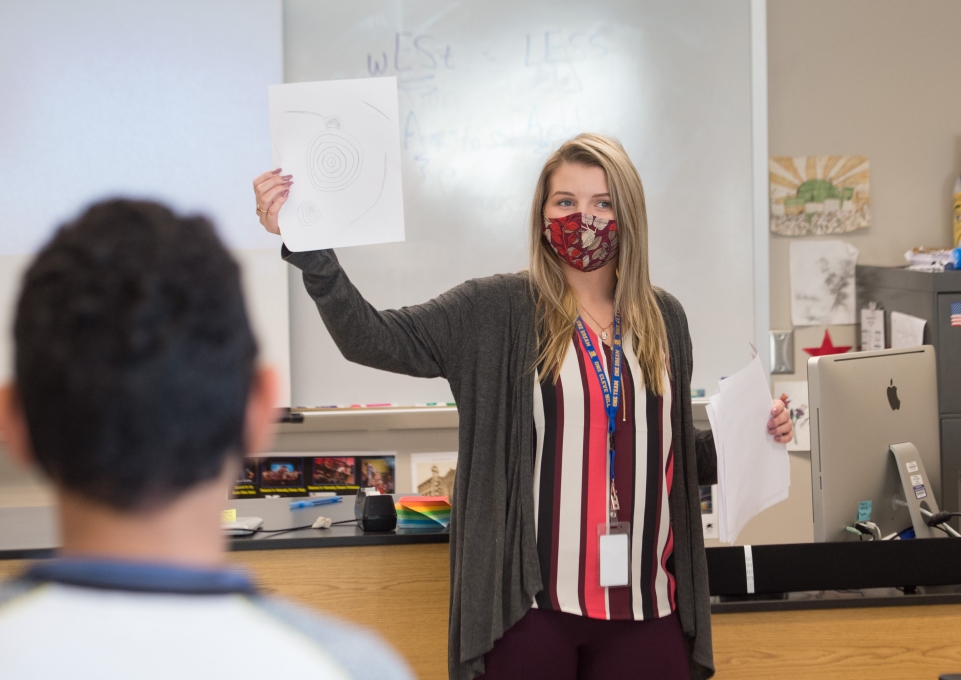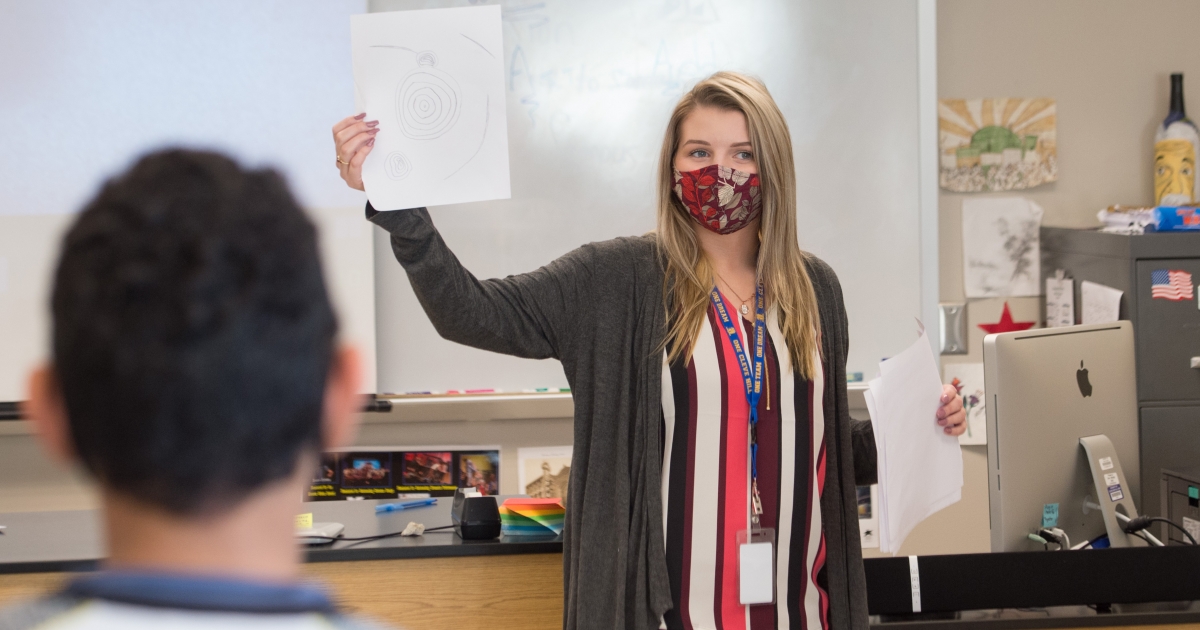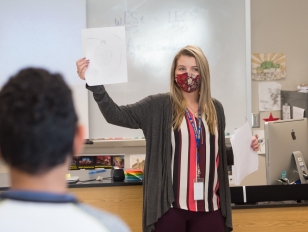
Heading into the fall semester, senior history and social studies education major Calista LeGault wasn’t sure how’d she complete her student teaching requirement in light of all the changes in schools from the coronavirus pandemic. In fact, she didn’t find out where she was going to be placed until a week before the school year started. Despite the uncertainty and short notice, however, LeGault has thrived this semester, and feels she’s getting a unique experience many prospective teachers will never have.
“I honestly feel like I’ve gotten two years’ worth of training and experience this semester,” LeGault said. “I really feel great about everything.”
LeGault is student teaching at Cleveland Hill Middle School in Cheektowaga, where she’s working with eighth-graders, teaching social studies. She’s just one example of how teacher candidates at Buffalo State College are adapting to teaching and learning through the pandemic.
“Our student teachers and teacher candidates have just been so resilient and flexible and up for the challenge,” said Wynnie Fisher, student teaching placement coordinator for the History and Social Studies Education Department. “We’re experiencing such a unique period in education right now, and they’ve maintained positive spirits throughout.”
“We see new learning, new skills that were never called upon, and new respect for the profession of teaching.”
While many of the details remained uncertain for LeGault over the summer, she took steps to prepare the best she could. She did research online, looked up activities she could do with students, and prepared for both middle and high school students, in order to be ready for either placement.
“I tried to get the creative juices flowing a little bit,” she said.
Once she received her placement, LeGault quickly had to figure out how to deal with students both in person and virtually. Cleveland Hill Middle School follows a hybrid schedule, allowing students to choose either online learning only, or a combination of in-person and virtual learning.
“I feel like I’ve become super, super tech-savvy, just with how to engage students online,” she said.
Teaching American history has been interesting this semester, LeGault said, especially given the pandemic, the recent protests over police brutality, and the 2020 presidential election. She’s had to learn in real time how to handle students’ questions about those events, as well as foster civil discussions.
In addition, the fears and stresses that adults experience during times of uncertainty can be magnified in a child or teenager, making it important to make sure the students’ mental well-being is a top priority, she said. It can be an overwhelming time for all involved.
“I try to just be confident and trust my abilities,” LeGault said.
Elizabeth Haynes, LeGault’s cooperating teacher and mentor at Cleveland Hill, said it’s a great time for LeGault to be student teaching, despite the challenges. For instance, Leagult is learning how to work with students she isn’t seeing every day.
“This is an incredibly strange time to be teaching, but it’s also offering such great opportunities,” Haynes said. “She’s learning the importance of social-emotional education. Calista is up for the challenge. She’s up for treating this like what it is, and that’s a really great opportunity to learn and grow as an educator.”
Emily Ziegler, a teacher candidate in the postbaccalaureate teacher certification program in art education, has been observing virtual art classes through the Buffalo Academy for Visual and Performing Arts. While it’s not quite the same as being in the classroom, Ziegler said, it’s still been a great experience.
“I have been getting real-time examples of concepts that I have been learning in my education classes, which has been truly valuable,” she said. “One of the things I have learned so far is how important ‘student-first’ teaching is, and making sure to be flexible and understand the stresses of the students, especially during this pandemic time.”
Ziegler said she’s learned that checking in with students during their classes can help alleviate their stress and help them concentrate, even in a virtual setting.
“That is something that I see as being extremely important, because it’s showing your students that you genuinely care about their mental health and well-being, as well as wanting them to succeed without over-stressing them,” she said. “We’ve also discussed communication quite frequently, more so during this pandemic time, and the importance of multiple methods of communication for students.”
Student teachers and teacher candidates are being watched more closely this year, said Wendy Paterson, dean of the School of Education, as New York State has expressed concerns over the quality of experiences they’ve been getting throughout the pandemic; however, there is more hope than worry.
“We see new learning, new skills that were never called upon, and new respect for the profession of teaching,” Paterson said. “Kudos to the student teaching supervisors and field experience faculty for their fierce advocacy and tireless devotion to high-quality clinical practice, no matter where the classroom—online or in physical space. True mentorship does not depend on the place, only the spirit of persistence and grace passed on to the student by the mentor. In that we are truly prospering.”
LeGault said she loves her students, her mentor teacher, Haynes, and the work they’re doing. She’s been lucky, she said.
“I fell in love with the classroom, and I love being around the students,” LeGault said. “I’m in a super great environment. I feel like I’m wanted here.”
Ziegler echoed the sentiment.
“Learning to teach online can be more complicated and difficult, but now I have examples of how to do it, and do it successfully,” she said. “It would be wonderful to get to be in the classroom and get to be learning in person, but I am very happy with how it has been going and what I’ve been able to do and see. I truly appreciate the opportunity I have been provided.”
Overall, Paterson said, she’s been impressed with the work Buffalo State teacher candidates are doing this semester.
“Our student teachers continue to amaze us with their inventiveness, insights, and flexibility,” she said. “Reports from grateful teachers echo the sentiments of the student teachers who write passionately about their newfound connections with students, brought to clarity in a computer-generated world.”
Pictured top: Student teacher Calista LeGault gives a social studies lesson to eighth-graders in Elizabeth Haynes's Cleveland Hill Middle School classroom.
Photo by Bruce Fox, campus photographer.



